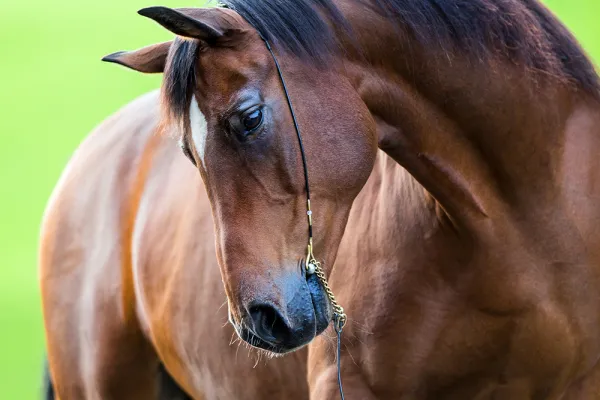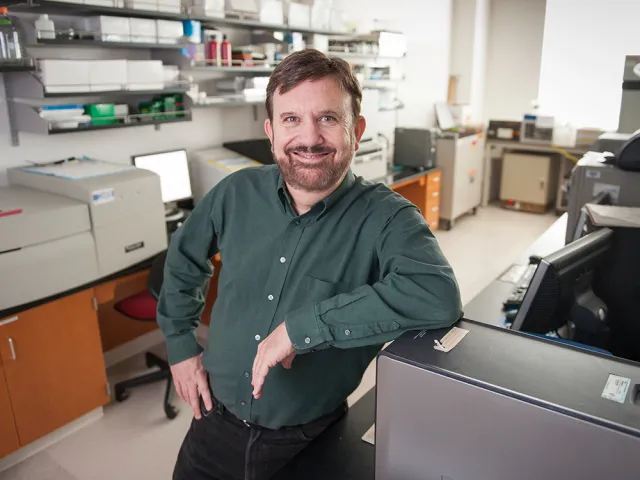Horses as Models for the Human Gut? Let Them Eat Worms
Research & Inquiry

Published January 29, 2014
Right now, some 150 million people worldwide are infected with the filarial nematode parasites that bring on the debilitating tropical disease of lymphatic filariasis, commonly known as elephantiasis, and African river blindness.
While the World Health Organization describes the disease as a “neglected tropical disease,” Steven Williams, Gates Professor of Biological Sciences at Smith, has been at the forefront, conducting extensive research projects designed to decipher the complicated molecular biology of such parasites, with the goal of eliminating these diseases. In 1994, Williams was the guiding force for the establishment of the Filarial Genome Project, under the auspices of the WHO, coordinating genome research on the parasites with the intention of developing new vaccines and drugs to prevent and ultimately eliminate human filariasis.
Most recently, Williams began a new research project to do a detailed study of a new aspect of the disease. It is the first known study of its kind.
“If we treat the human, make changes in the intestine and get rid of all the parasites, will changing the microbiome of that system affect anything? With the disappearance of the intestinal parasites in the tropics and Third World countries, will we see a dramatic increase in allergies and chronic autoimmune diseases—such as as Crohn’s disease, asthma and multiple sclerosis—that are occurring in the Western developed countries?” asks Williams, who created the first precise, practical way to detect the parasites that cause elephantiasis and African River blindness.

Molecular biologist Steven Williams is Smith’s Gates Professor of Biological Sciences.
And this is where the horse comes in.
“Horses are not a bad model for studying the interplay between parasites and their human hosts,” says Williams, who notes that the typical human and horse are similar hosts to a vast array of microbes and bacteria.
“The physiology and anatomy of a horse’s gut closely resembles that of a human. Horses ingest a lot of tiny parasitic nematode worms while eating grass. The worms impact the immune system while taking up permanent residence in their gastrointestinal tract,” he says. In both horses and humans, infection can lead to a variety of symptoms including retarded growth, weight loss and digestive disturbances.
Moreover, horses, in all their complexity, are quite prolific in producing environmental samples—that is, DNA-rich horse manure—that can be gathered right from their natural habitat. In fact the average 1,000-pound horse grazing on grass deposits about 35 pounds of manure a day.
Collecting the samples required for this metagenomic study from horses, rather than laboratory animals, has other advantages as well. Not a single animal was prodded or injected or confined during the course of the study—which began in the summer 2011 and aims to analyze the resident community of microbes, collectively known as the microbiome or ecosystem, following treatment with anti-parasitic drugs.
Once it was decided that the horse would be key to this study, Williams had to look no further than the herd of horses living on his own farm. Four horses provided the necessary raw material for his research. “We took fecal samples from the horses while they were infected, did egg counts per milligram of the parasites present and then treated horses with the wormer Ivermectrin. Then each day post treatment we collected new fecal samples and did more egg counts. We probably have 10 pounds of frozen poop in the lab freezer.”
Williams believes that his lab is the first in the country to conduct a metagenomics study of the microbiome of the gastrointestinal tract of horses following drug treatment in hopes of better understanding the interplay between the human gut and its ecosystem.
The Hygiene Hypothesis
In the last decade, scientists have come to recognize that for people who live in industrialized countries like the United States, modern hygiene has increased cleanliness. At the same time, it has diminished the likelihood of exposure to bacteria and infectious disease-causing parasites. Ultimately it has saved legions of lives.
But when it comes to health and disease, Williams is among those who say recent studies suggest a downside to being too clean. This hygiene hypothesis proposes that a dramatic increase in autoimmune disorders in industrialized countries may be due to the extermination of bacteria, not only the infectious kind (bad bacteria) but also diverse beneficial organisms (good bacteria), which are essential in regulating a body’s immune response system.
“Here in the United States, we have lived in a pretty clean environment for the past 100 years,” says Williams. “And while the numbers of parasitic infections are going down, we do seem to have skyrocketing increases in allergic and autoimmune diseases.
“If we are getting rid of one problem,” he wonders, “are we creating another bigger one?”
This is one aspect of what Williams is currently examining: the detrimental consequences of this hypervigilance about hygiene and subsequent war on bacteria, especially the species that are pathogenic and cause infectious diseases. In particular, eliminating the intestinal parasites along with the bacteria within the intestinal ecosystem, whether through sanitary measures, antibiotics or deworming drugs, also eliminates other microorganisms, such as the natural gut bacteria and fungi, which may be beneficial to the microbiome of the host body. This may upset the healthy balance of the gastrointestinal tract microbiome and, in turn, adversely affect the health of the horse (or human).
Keeping Track of the Parasites: From the U.S. to Africa
Recent studies suggest that Americans have higher levels of autoimmune disorders than those living in less developed regions. According to Williams, “If you go to the still-developing countries that have a lot of the wormy diseases that I study, you will notice that what they don’t have yet are a lot of autoimmune diseases and allergies.”
No doubt about it, Williams says, the equine gastrointestinal tract study may have a broadened significance for his longtime research in the tropics where he has focused on the molecular biology of parasites that cause filarial infections such as elephantiasis.
Indeed, as one of the world’s leading researchers on filarial parasites, Williams and his laboratory team—including many Smith students over the past several decades—have created the first precise, practical way to detect the intestinal parasites that cause lymphatic filariasis, elephantiasis and African river blindness, diseases that afflict 1.4 billion people worldwide. In the laboratory, they have sequenced millions of bases of DNA from these parasites and identified new genes, which continue to provide the information necessary to further develop new vaccines and drugs to prevent these debilitating tropical diseases.
“There is a global program under way to eradicate these infectious diseases, and the plan is to treat more than 1 billion people to obliterate the parasitic worms,” notes Williams.
“But my question is this: We’re treating people all over the world and getting rid of the worms that cause disease. And what happens as more and more anti-parasitic drugs are being developed and the disease-causing parasites—I call them squatters—are disappearing from the intestines of their human hosts?
“Meanwhile, the intestine is a huge organ, and the millions of bacteria, including worms, that live there spur the development of a healthy immune system and a healthy immune response to diseases. With all these drug treatments, I worry that we are getting rid of one problem and, by suppressing the natural development of the immune system, creating another huge problem for a system that possibly has gone awry.”
“It’s not a very popular idea in my field,” Williams adds, noting that he has set out to do the research nonetheless. “I’m not advocating stopping the treatments, I only want to understand what’s going on. If we better understand the interplay between parasites and hosts, maybe we can do something about the rise in autoimmune system disorders.”
What Goes In Must Come Out—and Be Analyzed
When all is said and done, it will be the sequencing of the metagenomes—that is, determining all the DNA in the bacterial communities found in the equine gastrointestinal tract—that will reveal new genetic information for Professor Steven Williams and his laboratory team.
“Metagenomics is the purest science,” says Williams. “It enables us to find everything that’s present in the microbiome, simply from the DNA we extract.”
Williams’ latest project seeks to survey the DNA extracted from the bacterial communities found in the lining of the horse’s gut. Then, by deciphering the genetic riddle of the microbial species there, he and his team hope to better understand what bacteria are present, both the good and the bad. Likewise, they can use the data analysis to better determine the ways in which drugs may, or may not, be helpful.
Pursuing that goal are Williams and his lab group (the undergraduates and graduate students he mentors and jokingly refers to as “the poop group”) who continue to conduct high-throughput sequencing tests for genomic DNA on manure samples—representing pretreatment with the antiparasitic medication Ivermectin and post-treatment—collected from four domestic horses in Williams’ own pastures. The results offer bioinformatics about the DNA of the bacterial species in the samples and allow the team to track individual bacterium species within the gastrointestinal tract throughout the duration of the treatment cycle.
Graduate student Ashanta Ester, currently a Wilens Fellow working on her master’s degree in biological sciences at Smith, is a part of the lab team focusing on the metagenomic DNA extraction aspect. Ester received her undergraduate degree from Elms College where she first began her involvement with this study with Janet Williams, associate professor of biology at Elms, who is collaborating on the project.
“The overall goal for this research is to get a better understanding of how these bacteria populations are affected by the treatment for helmenthics [worms],” Ester says. “We believe that this study will have human applications when it comes to devising a better treatment.”
Rachael Sirois GS ’13 also worked with Williams while earning her master’s degree at Smith and says she gained valuable experience with the processes of research including high-throughput sequencing.
The high-throughput DNA sequencing Sirois worked on in summer 2012 yielded a massive amount of genetic composition data from the samples provided, she said that summer. “We want to find as many bacteria species as we can with this data. One sequencing run generated 1,279,578 reads for sequences that then had to be organized and matched with already existing sequence databases in order to track individual species of bacteria,” she said. “This tells me that the microbiome [of the equine gastrointestinal tract] is very complex.”
For Sirois, who graduated from Stonehill College with a bachelor’s degree in biology, the experience with research methodology and the metagenomic DNA extraction turned out to be important for her professional aspirations. She is now a doctoral candidate in veterinary science at the University of Pennsylvania. “I didn’t ever think I would be in graduate school. I had no research skills at all,” she noted last summer while assisting Williams in the lab. “And now I do.”
How can a study of what goes on in a horse’s gastrointestinal tract help us learn more about combating parasitic diseases that affect millions of people worldwide? Smith Professor Steve Williams is conducting a unique research project to find out.